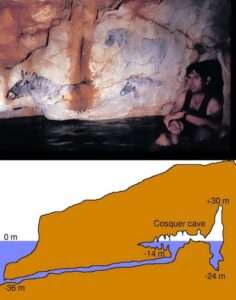Located in Cap Morgiou near Marseille, France, the Cosquer Cave presents an intriguing mystery, nestled 37 meters (121 feet) below the ocean’s surface. Its entrance lies submerged, hinting at a time when sea levels were significantly lower, enabling ancient humans to reach the cave without modern diving gear.
Stepping inside this wondrous underwater environment reveals a treasure trove of over 600 prehistoric artworks. These intricate paintings and carvings predominantly showcase an array of animals such as horses, bison, ibex, seals, and numerous hand stencils. Each artwork offers a unique glimpse into the daily lives and spiritual beliefs of the Upper Paleolithic societies that once called this region home.

The Cosquer Cave’s distinct entrance and delicate contents have led to stringent regulations governing access. Permission for any scientific exploration or study within its confines is strictly controlled. Recent endeavors have been focused on both researching and preserving this invaluable cultural heritage to ensure it endures for future generations.
Diving deeper into the Cosquer Cave offers a fascinating journey back in time, unraveling the mysteries of our ancient ancestors. By marveling at the intricate artworks adorning its walls, visitors can connect with a long-lost era and gain profound insights into the creativity and symbolism that defined early human societies.
As efforts continue to safeguard this unique archaeological site, the significance of the Cosquer Cave as a window into our past remains unparalleled. Through meticulous study and conservation, we strive to unlock its secrets and preserve its rich historical legacy for years to come.
In conclusion, the Cosquer Cave stands as a testament to the ingenuity and artistic prowess of our forebears, beckoning us to delve into its depths and unravel the enigmatic tapestry of prehistoric life that it holds within its submerged chambers.





